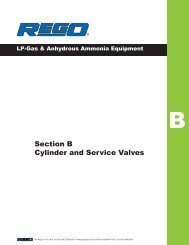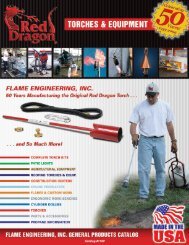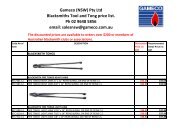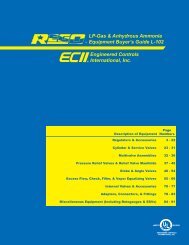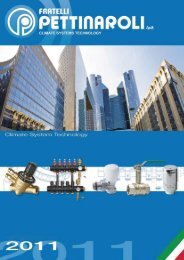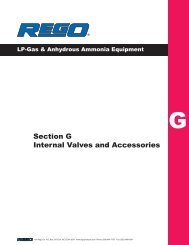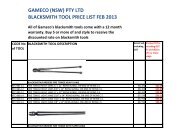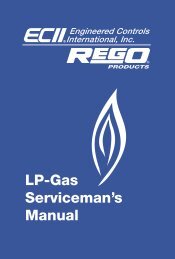Repair Kits Available By Part Number Section 2 Page - GAMECO
Repair Kits Available By Part Number Section 2 Page - GAMECO
Repair Kits Available By Part Number Section 2 Page - GAMECO
You also want an ePaper? Increase the reach of your titles
YUMPU automatically turns print PDFs into web optimized ePapers that Google loves.
WARNING: Installation, usage and maintenance of this product<br />
must be in compliance with all Engineered Controls International,<br />
Inc. instructions as well as requirements and provisions of NFPA<br />
# 54, NFPA #58, DOT, ANSI, all applicable federal, state, provincial<br />
and local standards, codes, regulations and laws.<br />
Inspection and maintenance on a periodic basis is essential.<br />
Installation and maintenance should be performed only by qualified<br />
personnel.<br />
Be sure all instructions are read and understood before installation,<br />
operation and maintenance. These instructions must be<br />
passed along to the end user of the product.<br />
CAUTION: Contact or inhalation of liquid propane, ammonia and<br />
their vapors can cause serious injury or death! NH3 and LP-Gas<br />
must be released outdoors in air currents that will insure dispersion<br />
to prevent exposure to people and livestock. LP-Gas must be kept<br />
far enough from any open flame or other source of ignition to<br />
prevent fire or explosion! LP-Gas is heavier than air and may not<br />
disperse or evaporate rapidly if released in still air.<br />
Foreword<br />
The 7606RM Remote Cable Release Kit has been specifically designed<br />
for versatile, multi-directional manual control of your ESV system.<br />
Cable arrangements can easily be adapted to your specific needs,<br />
allowing lines of control from 3 or more directions. The kit even permits<br />
remote release actuation from outside the fenced area of the average<br />
bulk plant. Two or more ESVs can be operated simultaneously with<br />
a single control.<br />
When installed, the entire control system remains exposed for flexibility<br />
and dependability. Pulleys are not required to change directions; nor<br />
is there need to run the cable through conduit or tubing which could<br />
cause friction or freeze up in bad weather.<br />
Extra cable clamps, etc. are available for more elaborate systems.<br />
<strong>Part</strong>s Included in the 7606RM Kit<br />
<strong>Part</strong> <strong>Number</strong> Description Quantity<br />
7606RM-1 Cable, 100 feet 1<br />
7605-73 Cable Clamps 16<br />
7606RM-3 Turnbuckle 1<br />
7606RM-2 Quick Link 1<br />
7606RM-1 Tension Spring 1<br />
7606RM-7 S-Hooks 8<br />
7606RM-5 Signs 3<br />
7606RM-301 Instructions 1<br />
<strong>Part</strong>s Not Included<br />
• 1" Standard weight pipe for terminal posts and support<br />
posts, as needed.<br />
• 1" Standard weight tees for cable guides, as needed.<br />
• 1" Standard weight caps for terminal posts, as needed.<br />
• Concrete for setting posts.<br />
• Good quality cable cutter.<br />
• Vise grip wrench for cable clamp installation.<br />
Installation Procedure<br />
1. Make a sketch of your plant layout, and determine where the terminating<br />
points of the remote manual release system should be. At least two<br />
remote cable lines going in two directions should be provided, in order<br />
to assure that one line will be approachable regardless of wind<br />
direction. Then, plan the cable system according to the suggestions<br />
herein, paying particular attention to how the cables are connected<br />
between primary and secondary lines of control (see figure 5).<br />
2. Install terminal posts and support posts as required. Support posts should<br />
be placed along primary and auxiliary lines approximately 15 feet apart.<br />
3. Install cable system, complete with tension spring (see figure 1 and 2). Adjust<br />
as necessary to provide proper shutdown action from all remote locations.<br />
7606RM Remote Manual<br />
ESV Cable Kit Installation<br />
Instructions<br />
4. Thoroughly test system by actuating several times, and make further<br />
adjustments as necessary.<br />
5. Complete system should be operated frequently, and adjusted wherever<br />
necessary to keep it in ready condition.<br />
6. It is recommended that a routing daily test procedure be established<br />
for your ESV system, as well as all other safety related equipment in<br />
the plant.<br />
Description of Control<br />
1. The basic 7606RM Cable Control System is installed as shown in Figure<br />
1. The primary cable (A) is stretched from the ESV location (B) to the<br />
terminal post (C), and is held taut by the tension spring (D).<br />
2. A short length of cable (E) is attached to the ESV latch release by means<br />
of an S-hook (F) (see Figure 3) and to the primary cable with a quick<br />
link (G), leaving a slight amount of slack to prevent premature closing<br />
of the ESV. The other end of the tension spring is attached to another<br />
terminal post (H), or directly to the piping or bulkhead by means of a<br />
simple cable linkage (see Figure 2).<br />
3. Support post (J) are mounted approximately 15 feet apart along the<br />
primary cable to prevent excessive whipping in severe windy conditions,<br />
and to help support the weight of the cable for extremely long runs.<br />
Instruction signs (K) are attached to the cable, plant fence or other<br />
suitable support in prominent locations.<br />
NOTE: If signs are installed on cable, they should be secured close to<br />
support posts, or terminal posts.<br />
4. Final adjustment of the cable system is provided by the turnbuckle (L).<br />
5. Pulling on the primary cable (A) at any point in its length will tighten and<br />
pull the short length of cable (E), pulling the ESV latch release to instantly<br />
close the emergency shut off valve. Letting the primary cable go will<br />
allow the ESV to be manually reopened.<br />
Description of Auxiliary Control<br />
1. Auxiliary release cables may be installed along the primary cable (A)<br />
at any point 3 feet or more from the quick link (G) or turnbuckle (L)<br />
(see Figure 4).<br />
2. An auxiliary post (M) is installed and a short cable (N) about 12 inches<br />
long is attached between the post and the primary cable as shown.<br />
The auxiliary release cable (O) is attached at right angles to the primary<br />
cable and run to terminal post (P), using support post (Q) as required.<br />
3. Adjust length of auxiliary cable (O) to eliminate slack, but do not pull<br />
primary cable out of alignment. For very long auxiliary cables, it may<br />
be necessary to add a tension spring attached to another terminal post<br />
to hold it taut without affecting primary cable.<br />
4. Simply reverse the arrangement in Figure 4 to add an auxiliary release<br />
cable on the other side of the primary cable (A).<br />
5. Place separate auxiliary release cables at least 2 feet apart.<br />
6. Many variations of arrangements shown are possible by applying the<br />
basic ideas shown in Figures 1 through 5 to meet individual needs. Call<br />
ECII or your Authorized Product Distributor if you need advice.<br />
Hints for Installation<br />
1. Cut cables carefully and square for easy installation of cable clamps.<br />
2. Squeeze clamps tightly with vise grip pliers or other tools to attach them<br />
securely to cable. Check each clamp to make sure it doesn’t slip.<br />
3. Don’t kink cables when handling. Unwind coils carefully. A kinked cable<br />
will act as a spring, making it difficult to properly adjust control systems.<br />
4. Squeeze each loop flat with fingers after clamping cables, to remote<br />
excessive spring action. This will make it easier to adjust the<br />
Continued on page 4



